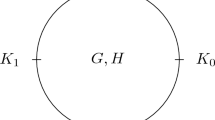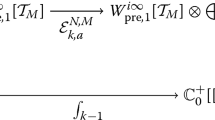Abstract
This paper deals with holomorphic self-maps of the complex projective plane and the algebraic relations among the eigenvalues of the derivatives at the fixed points. These eigenvalues are constrained by certain index theorems such as the holomorphic Lefschetz fixed-point theorem. A simple dimensional argument suggests there must exist even more algebraic relations that the ones currently known. In this work we analyze the case of quadratic self-maps having an invariant line and obtain all such relations. We also prove that a generic quadratic self-map with an invariant line is completely determined, up to linear equivalence, by the collection of these eigenvalues. Under the natural correspondence between quadratic rational maps of \({\mathbb {P}}^2\) and quadratic homogeneous vector fields on \({\mathbb {C}}^3\), the algebraic relations among multipliers translate to algebraic relations among the Kowalevski exponents of a vector field. As an application of our results, we describe the sets of integers that appear as the Kowalevski exponents of a class of quadratic homogeneous vector fields on \({\mathbb {C}}^3\) having exclusively single-valued solutions.
Similar content being viewed by others
Notes
The Test may be found in the ancillary files as Test.sage.
This is done in the ancillary file analysis-jacobi-ideal.m2.
The program indep.sage contains the details and computations of this part.
All the computations regarding this example can be found in the ancillary file case-study.ipynb.
The code for these algorithms can be found in the programs Test.sage and compute-h (the last one available as a .sage script and as an interactive .ipynb notebook).
This is done by the program testlist.sage.
References
Abate, M.: Index theorems for meromorphic self-maps of the projective space. In: Frontiers in Complex Dynamics, Princeton Math. Ser., vol. 51, pp. 451–462. Princeton Univ. Press, Princeton, NJ (2014). https://doi.org/10.1515/9781400851317-018
Atiyah, M.F., Bott, R.: A Lefschetz fixed point formula for elliptic complexes. II. Applications. Ann. Math. 2(88), 451–491 (1968). https://doi.org/10.2307/1970721
Audin, M.: Fatou, Julia, Montel. Lecture Notes in Mathematics, vol. 2014. Springer, Heidelberg (2011)
Baum, P.F., Bott, R.: On the zeros of meromorphic vector-fields. In: Essays on Topology and Related Topics (Mémoires dédiés à Georges de Rham), pp. 29–47. Springer, New York (1970). https://doi.org/10.1007/978-3-642-49197-9_4
Bonifant, A., Dabija, M., Milnor, J.: Elliptic curves as attractors in \(\mathbb{P}^2\). I. Dynamics. Experiment. Math. 16(4), 385–420 (2007). https://doi.org/10.1080/10586458.2007.10129016
Bonifant, A.M., Dabija, M.: Self-maps of \({\mathbb{P}}^2\) with invariant elliptic curves. In: Complex Manifolds and Hyperbolic Geometry (Guanajuato, 2001), Contemp. Math., vol. 311, pp. 1–25. Am. Math. Soc., Providence, RI (2002).https://doi.org/10.1090/conm/311/05444
Camacho, C., Sad, P.: Invariant varieties through singularities of holomorphic vector fields. Ann. Math. (2) 115(3), 579–595 (1982). https://doi.org/10.2307/2007013
Chazy, J.: Sur les équations différentielles du troisième ordre et d’ordre supérieur dont l’intégrale générale a ses points critiques fixes. Acta Math. 34(1), 317–385 (1911). https://doi.org/10.1007/BF02393131
Cosgrove, C.M.: Higher-order Painlevé equations in the polynomial class. I. Bureau symbol \(\rm P2\). Stud. Appl. Math 104(1), 1–65 (2000). https://doi.org/10.1111/1467-9590.00130
Fatou, P.: Sur les substitutions rationnelles. C. R. Acad. Sci., Paris 165, 992–995 (1917). https://gallica.bnf.fr/ark:/12148/bpt6k3118k.f992
Fatou, P.: Sur les équations fonctionnelles. Bull. Soc. Math. France 47, 161–271 (1919).https://doi.org/10.24033/bsmf.998
Fujimura, M.: The moduli space of rational maps and surjectivity of multiplier representation. Comput. Methods Funct. Theory 7(2), 345–360 (2007). https://doi.org/10.1007/BF03321649
Gelfand, I.M., Kapranov, M.M., Zelevinsky, A.V.: Discriminants, resultants, and multidimensional determinants. Mathematics: Theory & Applications. Birkhäuser Boston, Inc., Boston, MA (1994). https://doi.org/10.1007/978-0-8176-4771-1
Ghys, E., Rebelo, J.C.: Singularités des flots holomorphes. II. Ann. Inst. Fourier (Grenoble) 47(4), 1117–1174 (1997). https://doi.org/10.5802/aif.1594
Goriely, A.: A brief history of Kovalevskaya exponents and modern developments. Regul. Chaotic Dyn. 5(1), 3–15 (2000). https://doi.org/10.1070/rd2000v005n01ABEH000120. (Sophia Kovalevskaya to the 150th anniversary)
Grayson, D., Stillman, M.: Macaulay2, a software system for research in algebraic geometry (Version 1.11) (2018). http://www.math.uiuc.edu/Macaulay2/
Griffiths, P., Harris, J.: Principles of algebraic geometry. Wiley Classics Library. Wiley, New York (1994). https://doi.org/10.1002/9781118032527. Reprint of the 1978 original
Guillot, A.: Un théorème de point fixe pour les endomorphismes de l’espace projectif avec des applications aux feuilletages algébriques. Bull. Braz. Math. Soc. (N.S.) 35(3), 345–362 (2004). https://doi.org/10.1007/s00574-004-0018-7
Guillot, A.: Semicompleteness of homogeneous quadratic vector fields. Ann. Inst. Fourier (Grenoble) 56(5), 1583–1615 (2006). https://doi.org/10.5802/aif.2221
Guillot, A.: The geometry of Chazy’s homogeneous third-order differential equations. Funkcial. Ekvac. 55(1), 67–87 (2012). https://doi.org/10.1619/fesi.55.67
Guillot, A.: Quadratic differential equations in three variables without multivalued solutions: Part I. SIGMA Symmetry Integrability Geom. Methods Appl. 14, 122, 46 (2018). https://doi.org/10.3842/SIGMA.2018.122
Guillot, A., Ramirez, V.: Multipliers-of-self-maps-on-P2. GitHub repository (2018). https://github.com/valentermz/Multipliers-of-self-maps-on-P2
Guillot, A., Rebelo, J.: Semicomplete meromorphic vector fields on complex surfaces. J. Reine Angew. Math. 667, 27–65 (2012). https://doi.org/10.1515/CRELLE.2011.127
Ince, E.L.: Ordinary Differential Equations. Dover Publications, New York (1944)
Julia, G.: Sur les substitutions rationnelles. C. R. Acad. Sci., Paris 165, 1098–1100 (1917). http://gallica.bnf.fr/ark:/12148/bpt6k3118k.f1098
Kudryashov, Y., Ramírez, V.: Spectra of quadratic vector fields on \({\mathbb{C}}^2\): The missing relation (2018). http://arxiv.org/abs/1705.06340. Preprint arXiv:1705.06340 [math.CV] (to appear in Mosc. Math. J.)
Lins Neto, A.: Fibers of the Baum-Bott map for foliations of degree two on \(\mathbb{P}^2\). Bull. Braz. Math. Soc. (N.S.) 43(1), 129–169 (2012). https://doi.org/10.1007/s00574-012-0008-0
Mattuck, A.: The field of multisymmetric functions. Proc. Am. Math. Soc. 19, 764–765 (1968). https://doi.org/10.2307/2035879
Milnor, J.: Remarks on iterated cubic maps. Experiment. Math. 1(1), 5–24 (1992). http://projecteuclid.org/euclid.em/1048709112
Milnor, J.: Geometry and dynamics of quadratic rational maps. Experiment. Math. 2(1), 37–83 (1993). https://doi.org/10.1080/10586458.1993.10504267. With an appendix by the author and Lei Tan
Milnor, J.: Dynamics in one complex variable, Annals of Mathematics Studies, vol. 160, third edn. Princeton University Press, Princeton (2006). https://www.degruyter.com/view/product/451239
O’Brian, N.R.: Zeroes of holomorphic vector fields and Grothendieck duality theory. Trans. Am. Math. Soc. 229, 289–306 (1977). https://doi.org/10.2307/1998512
Painlevé, P.: Mémoire sur les équations différentielles dont l’intégrale générale est uniforme. Bull. Soc. Math. France 28, 201–261 (1900). https://doi.org/10.24033/bsmf.633
Ramírez, V.: The Woods Hole trace formula and indices for vector fields and foliations on \({\mathbb{C }}^{2}\) (2016). http://arxiv.org/abs/1608.05321. Preprint arXiv:1608.05321 [math.CV]
Ramírez, V.: Twin vector fields and independence of spectra for quadratic vector fields. J. Dyn. Control Syst. 23(3), 623–633 (2017). https://doi.org/10.1007/s10883-016-9344-5
The Sage Developers: The Sage Mathematics Software System (Version 8.1) (2017). http://www.sagemath.org
Ueda, T.: Complex dynamics on projective spaces—index formula for fixed points. In: Dynamical systems and chaos, Vol. 1 (Hachioji, 1994), pp. 252–259. World Sci. Publ., River Edge, NJ (1995). https://doi.org/10.1142/9789814536165
Acknowledgements
The authors thank Jawad Snoussi and Javier Elizondo for helpful conversations, and Marco Abate and Masayo Fujimura for providing useful references.
Author information
Authors and Affiliations
Corresponding author
Additional information
Communicated by Filippo Bracci.
Publisher's Note
Springer Nature remains neutral with regard to jurisdictional claims in published maps and institutional affiliations.
A.G. gratefully acknowledges support from Grant PAPIIT-IN102518 (UNAM, Mexico). V.R. was supported by the Grants PAPIIT IN-106217 and CONACYT 219722, and the PRESTIGE post-doc program (coordinated by Campus France and co-financed under the Marie Curie Actions-COFUND of the FP7). He also acknowledges the support of the Centre Henri Lebesgue ANR-11-LABX-0020-01.
Appendix A: A Relative Fixed-Point Formula
Appendix A: A Relative Fixed-Point Formula
We give here an elementary proof of relation (6) following the lines of the proof of [31, Sect. 12, Thm. 12.4]. A more conceptual one, based on the Atiyah-Bott fixed-point theorem, appears in the unpublished notes [34].
Theorem 6
Let \(f:{\mathbb {P}}^2\rightarrow {\mathbb {P}}^2\) be a rational map, \(\ell \subset {\mathbb {P}}^2\) a line such that \(f(\ell )\subset \ell \). Suppose that \(f|_\ell \) has the fixed points \(p_1\), ..., \(p_{k}\) and that these are simple. Let \(\lambda _i\) and \(\mu _i\) be be the eigenvalues of Df at \(p_i\), with \(\lambda _i\) the eigenvalue tangent to \(\ell \). Then,
Proof
In homogeneous coordinates \([z_1:z_2:z_3]\), let \(\ell \) be given by \(z_1=0\) and f be given by
for \({\widehat{Q}}\) and \({\widehat{R}}\) homogeneous polynomials of degree d and \({\widehat{P}}\) a homogeneous polynomial of degree \(d-1\). Consider the affine chart \(z_3\ne 0\) and suppose, without loss of generality, that it contains the \(d+1\) fixed points of \(f|_\ell \). In the coordinates [x : y : 1], f is given by
where \(P(x,y)={\widehat{P}}(x,y,1)\) and so on. Let \(y_1\), ..., \(y_{d+1}\) be the fixed points of f within \(\ell \). Consider the rational one-form in \(\ell \)
Since all the fixed points of \(f|_\ell \) are within the chosen affine chart, \(R(0,y)=cy^d+\cdots \) for some \(c\ne 0\). This implies that \(\lim _{y\rightarrow \infty } P(0,y)/R(0,y)=0\) and that \(\lim _{y\rightarrow \infty } Q(0,y)/R(0,y)\in {\mathbb {C}}\). Hence, \(\eta \) has a pole at \(\infty \) with residue \(-1\). The other poles of \(\eta \) are given by the fixed points of \(f|_\ell \). Let us calculate the corresponding residues. On the one hand, \(y-Q(0,y)/R(0,y)\), which gives the restriction of f to \(\ell \), has, for its Taylor development at \(y_i\),
On the other, a straightforward computation shows that
The Residue Theorem allows us to conclude.\(\square \)
Remark 3
It is worthwhile mentioning that there is no analogous result for other kinds of curves. Consider the following five-parameter family of quadratic maps of \({\mathbb {P}}^2\):
Every element f of this family preserves the conic Q given by \(z_1z_3-z_2^2=0\). A generic one is holomorphic and has seven different fixed points. The three fixed points of f on Q are \(p_0=[1:0:0]\), \(p_1=[1:1:1]\) and \(p_\infty =[0:0:1]\). A straightforward calculation shows that the map that to each f associates the set of values
has rank five at a generic point, this is, there is only one relation for the eigenvalues of the derivatives of f of the fixed points in Q. This relation is necessarily Fatou’s one (1) for \(f|_Q\), and no other relation holds.
Rights and permissions
About this article
Cite this article
Guillot, A., Ramírez, V. On the Multipliers at Fixed Points of Quadratic Self-Maps of the Projective Plane with an Invariant Line. Comput. Methods Funct. Theory 19, 687–716 (2019). https://doi.org/10.1007/s40315-019-00293-w
Received:
Revised:
Accepted:
Published:
Issue Date:
DOI: https://doi.org/10.1007/s40315-019-00293-w




